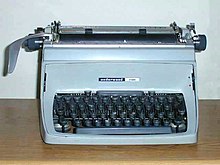Carriage return
This article needs additional citations for verification. (January 2008) |
A carriage return, sometimes known as a cartridge return and often shortened to CR, <CR> or return, is a
Typewriters

Originally, the term "carriage return" referred to a mechanism or lever on a typewriter. For machines where the type element was fixed and the paper held in a moving carriage, this lever was on the left attached to the moving carriage, and operated after typing a line of text to cause the carriage to return to the far right so the type element would be aligned to the left side of the paper. The lever would also usually feed the paper to advance to the next line.
Many electric typewriters such as
To improve the keyboard for non-English-speakers, the symbol ↵ (
↵) was introduced to communicate the combined carriage return and line feed action.
Computers
In
The carriage return and line feed functions were split for practical reasons:
- Carriage return by itself provided the ability to overprint the line with new text. This could be used to produce bold or accented characters, underscores, struck-out text, and some composite symbols.
- Early mechanical printers were too slow to return the carriage in the time it took to process one character.[why?] Therefore, the time spent sending the line feed was not wasted (often several more characters had to be sent to ensure the carriage return had happened before sending a printing character). This is why the carriage return was always sent first.
- It was then also possible to fit multiple line feed operations into the time taken for a single carriage return—for example for printing doublespaced text, headers/footers or title pages—to save print and transmission time without the need for additional circuitry or mechanical complexity to "filter out" spurious additional CR signals.
As early as 1901, Baudot code contained separate carriage return and line feed characters.
Many computer programs use the carriage return character, alone or with a line feed, to signal the end of a line of text, but other characters are also used for this function (see
In both ASCII and Unicode, the carriage return is assigned code point 13 (or 0D in hexadecimal); it may also be seen as control+M or ^M. In character and string constants in the C programming language and in many other languages (including representations of regular expressions[2][3]) influenced by C, \r denotes this character.[4]
See also
- Newline
- Enter key
- Soft return
- Hard return
- Unix2dos
- C0 and C1 control codes
References
- ^ "CRLF". MDN Web Docs. Archived from the original on 2024-03-04. Retrieved 2024-03-04.
- ^ "Regular expression syntax reference". JetBrains. Archived from the original on 2023-10-03. Retrieved 2024-03-04.
- ^ Jan Goyvaerts. "Regular Expressions Quick Start". regular-expressions.info. Archived from the original on 2024-02-21. Retrieved 2024-03-04.
- ^ Eric S. Roberts (1995). The Art and Science of C. Addison-Wesley. p. 311.
